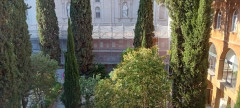Restauration of the wall of the Campo Santo Teutonico
Work has begun, particularly at the entrance and on the balustrade of the historic cemetery wall of Campo Santo Teutonico, and should be completed by November.
As an emergency measure, the German government is providing the Archconfraternity of the Sorrowful Mother of God with the funds to maintain access to this historic German cultural site. The wall was The wall was built under Pope Pius VI Braschi (1775-1799) in the Rococo style, together with the "Hospice", as compensation for the expropriation of part of the cemetery and neighbouring property of the Archconfraternity.
Unfortunately, dozens of building sites were opened in Rome at the same time, so that the visit to the city suffered some damage; not only Piazza Venezia and Piazza Navona have more or less disappeared, but also in St Peter's you can see neither Michelangelo's Pietà nor Bernini's canopy. But the renewal of the wall is absolutely necessary and at least does not significantly affect the visit to the German cemetery.
The cemetery wall has a walkway on its crown at a height of around 3.5 metres, which has not been allowed to be used since the Lateran Treaties of 1929, but which used to lead from the "Hospice" to the "Damenstift". Thanks to this walkway, it is now relatively easy to renovate the balustrade.
The wall forms the state border of the Vatican state. The Campo Santo Teutonico is Italian soil, but extraterritorial territory of the Vatican State. During the German occupation of Rome in 1943/44, this special legal and topographical situation enabled the Irish priest Hugh O'Flaherty to help 6,000 people in danger to escape from the Nazis from the college. The booklet below illustrates in words and pictures the significance of the Wall in this historical context
Campo Santo Teutonico Video History of the building
- Details
- Written by: Stefan Heid
- Category: Roman notes
 Römisches Institut der Görres-Gesellschaft
Römisches Institut der Görres-Gesellschaft







